In this article, you’ll learn What is Electric Power Steering System? Its diagram, parts, working, types, and Symptoms all are explained with pictures.
Also, you can download the PDF file at the end of this article.
What is Electric Power Steering?
In today’s new cars, electric power steering is a standard and advanced technology for highly automated driving. Also known as motorized power steering (MDPS), it uses an electric motor to assist the vehicle’s driver.
This electric motor can be found directly on the steering rack or the steering column. This type of power steering works by using sensors that measure the amount of torque applied to the steering wheel by the driver and using a computer to decide how much assistance to apply.
Computers in most systems adjust the steering effort based on the vehicle’s speed: a light steering effort is useful for parking. In contrast, a more pronounced steering effort at highway speeds makes the driver feel more controlled and stable.
EPS removes many components, such as the pump, hoses, fluid, drive belt, and pulley. Consequently, electric power steering systems are generally smaller and lighter than hydraulic power steering systems. In addition, they have variable power assist. These systems are more expensive and are used in sports- and luxury cars.
Let’s understand its components in detail below.
Read More: Different Types of Power Steering System used in Vehicles
Parts of Electric Power Steering
Following are the parts of electric power steering system:
- Steering wheel
- Electric motor
- Electronic control unit (ECU)
- Torque sensor
- Steering angle sensor
- Reducing gearbox
- Battery
- Speed sensor
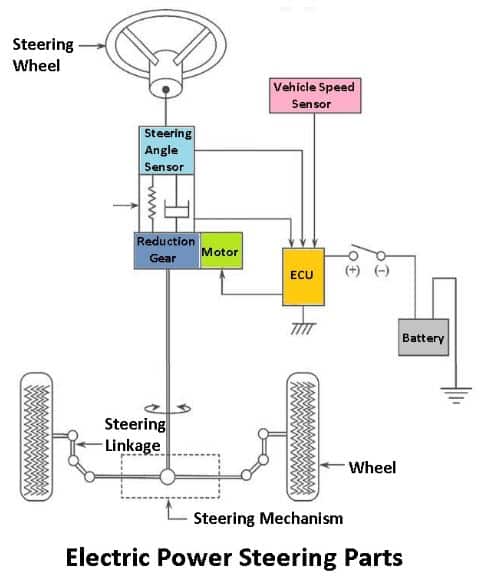
#1 Steering Wheel
The main function of the steering system is to provide steering of the vehicle as desired by the driver. It converts the rotary movement of the steering wheel into the angular turning of the front wheels.
#2 Electric Motor
Electric power steering consists of an electric motor that controls the vehicle steering and provides an optimal and enjoyable steering experience. The motor used for EPS is a permanent magnetic field DC motor. This motor must be able to generate torque without rotating and must also be able to reverse rotation rapidly.
#3 Electronic Control Unit (ECU)
The electronic circuit unit is the heart of the EPS system. An ECU is responsible for controlling the steering sensor and vehicle speed sensor inputs and outputs. Apart from this, it performs three other functions, which are also considered essential.
ECU manages the motor current and steering wheel mechanism. The software in the ECU is useful for monitoring the ESP system and its components, as well as for self-diagnosis and fail-safe functions. It communicates between ECU and ESP system i.e.; the ESP can read data stored in ECU.
#4 Torque Sensor
It is a device used in electric power steering systems to measure the torque applied by the driver to the steering wheel. By calculating this data, the electronic control unit determines how much steering assistance to apply to the electric motor.
The torque sensor consists of input and output shafts connected by a torsion bar. The input shaft has splines, while the output shaft has slots. By moving the input and output shafts, torque is created in the torsion bar, which is magnetized and then converted into voltage.
#5 Steering Angle Sensor
It measures the position angle and rate of turn of the steering wheel. Simply put, it matches the steering wheel with the vehicle’s wheels to determine where the driver wants to steer. Steering angle sensors are mounted in the steering column of a vehicle. In an ESP system, more than one angle sensor is used to provide redundancy and data verification.
#6 Reduction Gear
When the steering wheel is returned from large steering efforts, such as when turning in an intersection, this reduction gear provides smooth steering corrections as well as improved comfort when the steering wheel is returned from large steering efforts, like when turning in straight lines.
#7 Battery
As I said, the ESP system works with the help of an electric motor and a control unit which consists of some sensors. To do this, the motor runs on a battery and uses electrical power to assist in steering when the driver turns the wheel.
#8 Speed Sensor
Speed sensors are used in the ESP system to sense the car’s speed and adjust the amount of compensation or assistance to provide the feel of the driver being in control at all times so that you feel as if you are always taking control of the steering wheel.
Read Also: What is the function of an electronic ignition system?
Working of Electric Power Steering
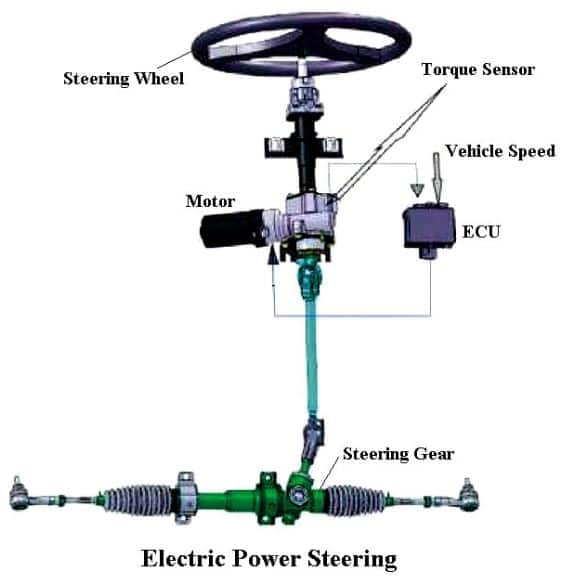
As soon as the driver provides input through the steering wheel, the electronic sensors attached to the steering column pick up this input and pass it on to the vehicle’s electrical control unit for processing.
There are several inputs that the vehicle’s electronic control unit analyzes and sends a voltage signal to the electric motor located at the end of the steering column to indicate that the gears are in a continuous mesh with the pinion gear so that the vehicle can move forward.
It is these voltage signals sent by the ECU that initiate the motor that is powered by the vehicle’s battery and provide special torque depending on the value of the voltage signals received from the ECU.
A gear follows the electric motor in constant mesh with the pinion gear. As a result, it starts transmitting torque to the manifold’s pinion gear which uses torque from the rack through which it is connected. This torque applied by the pinion to the rack rotates the rack, which turns the front wheels as required by the driver.
Read Also: Types of Spark Plugs and Their Working [Explained]
Types of Electric Power Steering
Following are the important types of electric power steering systems:
- Column Assist Type (C-EPS): A column assist (C-EPS) type has a power assist unit, torque sensor, and controller that are all integrated into the steering column, and they are all connected through the steering column.
- Pinion assist type (P-EPS): A pinion assist type (P-EPS) steering system uses a power assist unit attached to the pinion shaft of the steering gear so as to provide power assistance to the driver. Pinion assist electric power steering generally works better with smaller cars.
- Direct drive type (D-EPS): There are several advantages of direct-drive systems, such as low inertia and friction, which are achieved because the steering gear and assist unit are part of the same unit.
- Rack assist type (R-EPS): The assisting unit is linked to the steering gear in the R-EPS type. In the case of rack assist electric power steering systems, due to their relatively low inertia, they can be applied to mid- to full-sized vehicles since the reduction ratios of the gears make them relatively inert.
Read Also: What are the Symptoms of a Crankshaft Position Sensor?
Advantages
- The ESP system provides greater fuel efficiency as the motor only draws power when the vehicle turns.
- These power steering systems eliminate hydraulic fluid maintenance from time to time.
- Since the ESP system does not have hoses, hydraulic fluid, and a drive belt and pulleys on the engine, this makes it energy efficient and environmentally friendly.
- It may also enable any driver-assistance or convenience feature, including turning the wheels without steering input.
- In addition, it offers lane-keep assistance, automatic parking, lane change, and vehicle guidance around obstacles.
- The ESP system allows the vehicle to be driven on automatic pilot by the onboard computer.
Disadvantages
- The ESP system has improved auto efficiency and safety, making them relatively expensive compared to conventional hydraulic steering.
- If ESP system parts wear out, they can only be repaired with specialized diagnostic equipment and advanced tools.
- Cars with ESP are great, but the owner will face a significant bill when it fails due to a computer failure or sensor damage.
- If the system is not calibrated properly, ESP can feel less linear than hydraulic power steering.
- The design of the electric power steering is complex.
Read Also: What is Timing Belt In Car? Their Working and Symptoms [PDF]
Symptoms of ESP System
The following are several symptoms that indicate the EPS system is failing:
- ESP warning light
- Poor power assist
- Noise from the ESP motor
- Vehicle pulls in one direction
- Vibration from steering rack
- Soft steering wheel at high speeds
#1 ESP Warning Light
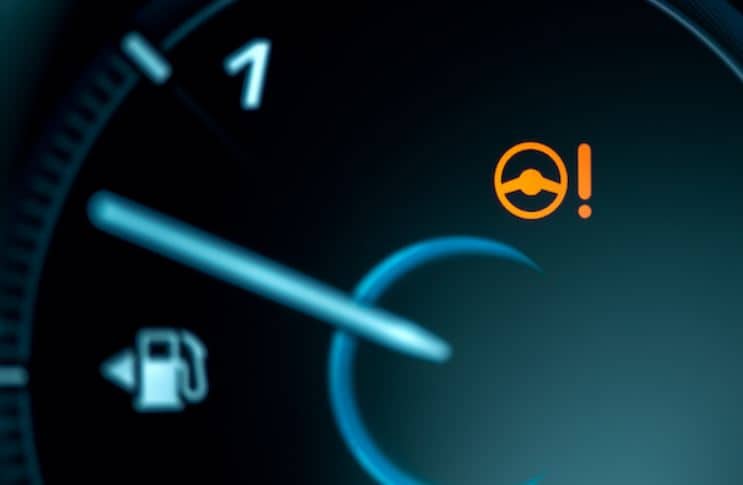
If the electric power steering fails, it causes the ESP warning light on the car’s dashboard to turn on. The light usually illuminates as red or yellow, which means there is a problem with the power steering.
#2 Poor Power Assist
If parts of the ESP system wear out, you may notice a reduction in power assist. As a result, it will be more difficult to turn the steering wheel. A poor power assist is nothing but a loss of power assist, which can happen suddenly or gradually.
The sudden loss of power assist makes it difficult to keep the vehicle under control. If it happens gradually, you may not notice at first, but over time, it will make difficult to turn the steering wheel.
#3 Noise from the ESP motor

If there is a problem with the ESP system, you may hear a strange noise from the power steering motor. The grinding of the gears against each other inside the motor causes this noise. The noise will get louder (whining) as the EPS system fails.
#4 Vehicle Pulls in One Direction
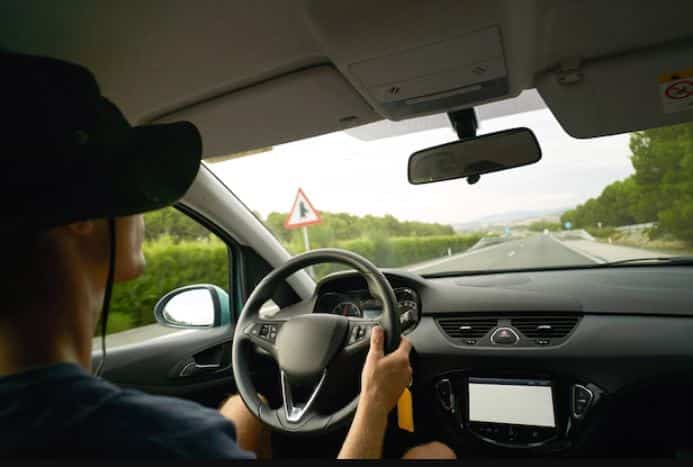
This is also a symptom of the ESP system, due to which the vehicle starts pulling to one side. This can be dangerous, making it difficult to keep the vehicle in its lane. The leading cause of this problem is usually a bad sensor or a faulty power steering motor.
#5 Vibration from Steering Rack
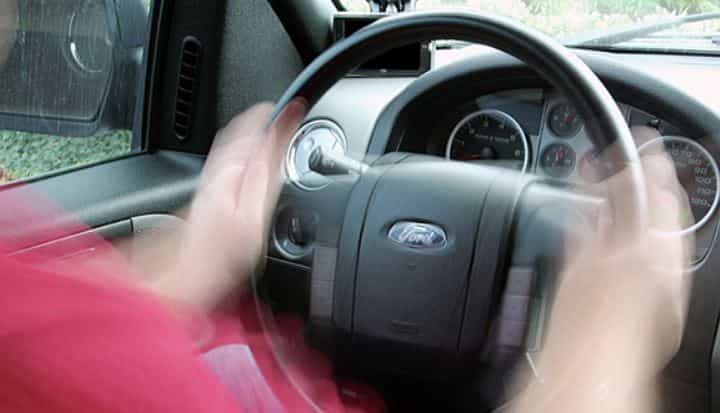
If you feel any vibration in the steering wheel, a mechanic must check it out as soon as possible. In this power steering, it uses a rack and pinion to convert the rotational motion of the steering wheel into linear motion, resulting in turning the wheels. If the rack and pinion are not correctly aligned, this can cause vibration in the steering wheel.
#6 Soft Steering Wheel at High Speeds
If the EPS system fails, you may notice that the steering wheel is softer than usual at high speeds. The ESP system provides the ability to adjust the level of assistance depending on driving conditions.
For instant, it provides more assistance at low speeds in hard turnings and less assistance at high speeds in easy turnings. Therefore, the steering will become stiff or hard at higher speeds and at slower speeds, much softer.
Wrapping It Up
The conclusion I can draw is that electric power steering is necessary for modern cars. During driving, the electric power steering system provides good handling as well as a more comfortable and less fatiguing driving experience.
I hope I have covered everything in this article. If I missed something, or if you have any doubts, let me know in the comments. If you liked this article, please share it with your friends.
Want free PDFs direct to your inbox? Then subscribe to our newsletter.
Download PDF of this article:
You might like to read more in our blog: